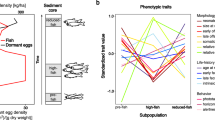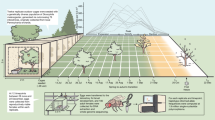Summary
Large changes in genotypic frequencies have been observed over a 2-year period in a population of Daphnia magna polymorphic for two alleles of malate dehydrogenase. These changes were not the result of migration or random drift. Genotypic differences in both parthogenetic and sexual egg production were observed. There was a strong correlation between the parthogenetic fecundities of the genotypes and their frequencies 1 month later. Sexual egg production was enhanced among low fitness genotypes. These observations strongly suggest that populations of Daphnia magna consist of a limited number of ecologically differentiated clones.
Similar content being viewed by others
Article PDF
References
Dobzhansky, T H, Lewontin, R C, and Pavlosky, O. 1964. The capacity for increase in chromosomally polymorphic and monomorphic populations of Drosophila pseudoobscura. Heredity, 19, 597–614.
Fraser, B D. 1972. Population dynamics and recognition of biotypes in the pea aphid. Can Ent, 104, 1729–1733.
Green, F. 1954. Size and reproduction in Daphnia magna. Proc Zool Soc London, 124, 535–545.
Hebert, P D N. 1973. Phenotypic variability of lactate dehydrogenase in Daphnia magna. J Exp Zool, 186, 33–38.
Hebert, P D N. 1974. Enzyme variability in natural populations of Daphnia magna. II. Genotypic frequencies in permanent populations. Genetics (in press).
Hebert, P D N, and Ward, R D. 1972. Inheritance during parthenogenesis in Daphnia magna. Genetics, 71, 639–642.
Hebert, P D N, Ward, R D, and Gibson, J B. 1972. Natural selection for enzyme variants among parthenogenetic Daphnia magna. Genet Res 19, 173–176.
King, C E. 1972. Adaptation of rotifers to seasonal variation. Ecology, 53, 408–418.
Lewontin, R C. 1965. Selection for colonizing ability. In The Genetics of Colonizing Species, Ed. H. G. Baker and G. L. Stebbins. Academic Press, New York.
MaCarthur, J W, and Baillie, W H T. 1929. Metabolic activity and duration of life. I. Influence of temperature on longevity in Daphnia magna. J Exp Zool, 53, 221–242.
MaCarthur, R H, and Wilson, E O. 1967. The Theory of Island Biogeography. Princeton University Press, Princeton.
Slobodkin, L B. 1954. Population dynamics in Daphnia obtusa. Kutz Ecol Monogr, 24, 69–88.
Sokal, R R, and Sonleitner, F J. 1968. The ecology of selection in hybrid populations of Tribolium castaneum. Ecol Monogr, 38, 345–379.
Author information
Authors and Affiliations
Rights and permissions
About this article
Cite this article
Hebert, P. Ecological differences between genotypes in a natural population of Daphnia magna. Heredity 33, 327–337 (1974). https://doi.org/10.1038/hdy.1974.99
Received:
Issue date:
DOI: https://doi.org/10.1038/hdy.1974.99
This article is cited by
-
Competition in natural populations of Daphnia
Oecologia (1995)
-
Photoperiod and temperature as inducers of gamogenesis in a dicyclic population of Scapholeberis armata Herrick (Crustacea: Cladocera: Daphniidae)
Hydrobiologia (1991)
-
Reproductive effort in Daphnia galeata: comparison of reservoir and pond populations
Hydrobiologia (1991)
-
Multilocus differentiation and population structure in a selfer, wild emmer wheat, Triticum dicoccoides
Heredity (1987)
-
Reproductive variations of cladocerans in grasslands periodically flooded for irrigation in Mantecal, Venezuela
Hydrobiologia (1987)



